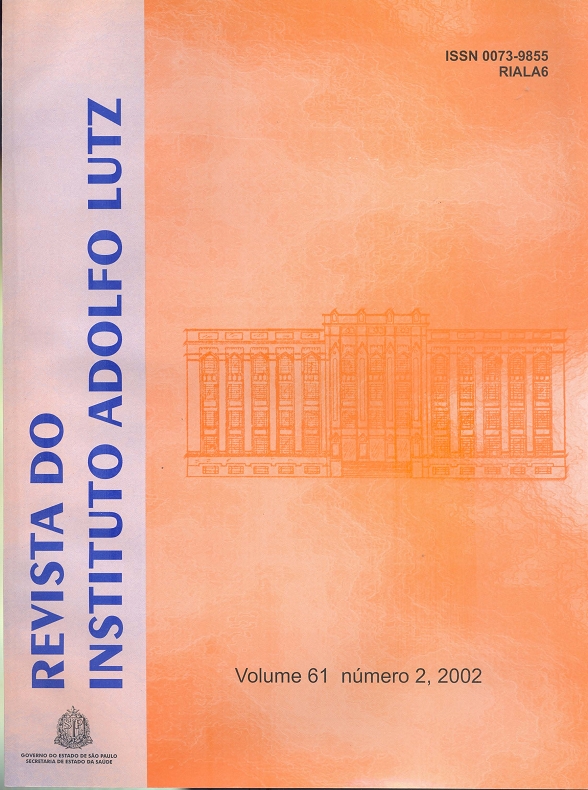Abstract
In the period of January 1993 to September 2000 were analyzed at Adolfo Lutz Institute 236 samples of olive oils and in all of the samples the purity was verified through the analysis of the fatty acids profile, using gas chromatographic techniques. In 136 samples it was also verified if the classification on the label was in accordance with the quality. The absorption measures in the ultraviolet spectra, at 232 and 270 nm were the parameters evaluated. It was observed that 43 samples (18,2%) were adulterated and the main fraud type was the addition of vegetable oils of lower commercial value, mainly soybean oil. Considering the label evaluation, 7 samples (5,1%), of the 136 analyzed, presented incorrect quality
classification. It was verified that from the total samples, 77 were picked by the Sanitary Survey Watch and, of these, 67 were picked from 1997 to 2000, due the cooperation programs established from 1997 between the Adolfo Lutz Institute and the Center of Sanitary Survey Watch of the State of São Paulo.
References
1. Antoniassi , R. et al. Avaliação das características de identidade e qualidade de amostras de azeite de oliva. Braz. J. Food Technol., 1(1/2): 32-43, 1998.
2. Aued, S. Adulteração de azeite de oliva. Bol. Inst. Adolfo Lutz, 1(1).:8, 1991.
3. Aued-Pimentel, S. et al.- Avaliação de parâmetros físicos e químicos no estudo da adulteração do azeite de oliva. Rev.Inst. Adolfo Lutz, 54 (2): 69-77, 1994.
4. Aued-Pimentel, S. et al. Monitoramento da qualidade de azeite de oliva comercializados na cidade de São Paulo. In: 6o Congresso e Exposição Latinoamericano sobre Processamento de Óleos e Gorduras , Campinas, 1995.
5. Aued-Pimentel, S. et al. Multivariate analysis applied to quality assessment of olive oil commercialized in São Paulo, Brazil. In: World Conference on Oilseed and Edible Oils. Processing, 1996 Istambul. The Proceedings of World Conference on oilseed and Edible Oils Processing. Champaign, Illinóis, AOCS Press, 1998. v.II. p.205 – 211.
6. Badolato, E.S.G. et al. Óleo de oliva - Avaliação de sua qualidade. Rev. Inst. Adolfo Lutz, 41(1):63- 70, 1981.
7. Boskou, D. Olive oil: chemistry and technology. AOCS Press, Champaign, IL,1996. 161p.
8. Brasil, Leis, decretos, etc. Resolução n° 482/99 da Diretoria Colegiada da Agência Nacional de Vigilância Sanitária. Diário Oficial, Brasília, 13 out. 1999. Seç. I, nº196-E, p. 82-87. Aprova o Regulamento Técnico referente a Óleos e Gorduras Vegetais, constante do anexo desta Resolução (Anexo 13: Azeite de oliva).
9. Codex Alimentarius Commission. In: Fats, Oils and Related Product. Rome, FAO/WHO, vol. 8, p. 41-47, 1993. ( Codex Stan 33-1981).
10. Codex Alimentarius Commission. Codex standards for edible fats and oils. Rome,FAO/WHO, 1987, p. 46-75, (CAC -vol. 17).
11. Dionisi, F.; Prodolliet, J.; Tagliaferri. Assessment of olive oil adulteration by reversed phase high performance liquid chrometography/ amperometric detection of tocopherols and tocotrienols. J. Am. Oil Chem.Soc., 72(12):1505-1511, 1995.
12. Fellat-Zarrouck, K.; Boutellier, J.C.; Maurin, R. – HPLC detection of adulterations of olive oil by seed oils. Rev. Fran.Corps Gras, 35(10):383-385, 1995.
13. Firestone, D. et al. Detection of adulterates and misbranded olive oil products. J. Am. Oil. Chem.Soc, Champaign, 62: 1558-1562, 1985.
14. Flor, R.V.; Tiet, L.T.- Development of HPLC criteria for determination of purity of commercial olive oils. U.S.Customs Serv. Tech.Bull., 18(.3): 75-90, 1994.
15. Gracian, J. The chemistry and analysis of olive oil. In: BOEKENOOGEN, H.A. Analysis and Characterization of oils, fats and fat products, Interscience Publishing, London, 1968, vol. 2, p.317-591.
16. Instituto Adolfo Lutz (São Paulo).Normas analíticas do Instituto Adolfo Lutz. . v.1: métodos químicos e físicos para análise de alimentos. 3º ed. São Paulo, IMESP, 1985, p. 245-66.
17. International Olive Oil Council. Trade Standard Applying to Olive Oil and Olive-Pomace Oil. Resolution nº Res-2/80-IV/99 .COI/T.15/NC nº2/Rev.9, 10 june 1999.
18. Kapoulas, V.M.; Andrikopoulos, N.K. Detections of olive oil adulteration with linoleic acid-rich oils by reversed-phase highperformance liquid chromatography. J.Chromatogr., 366:311-20,
19. Kapoulas, V.M.; Passloglou-Emmanouilidou, S. Detections of adulterations of olive oil with seed oils by a combination of column and gas liquid chromatography. J. Am. Oil Chem.Soc, 586:694-7,1981.
20. Kiritsakis, A.; Markakis, P. Olive oil: a review. Adv. Food Res., 31:453-82, 1987.
21. Morita, A. Tempero no azeite. Supermercado Moderno. Janeiro: 24-31, 2000.
22. Soares, L.V.; Rodrigues-Amaya, D. Identificação e quantificação de adulterantes em óleo de oliva por cromatografia gasosa. Bol SBCTA, 15(1):1-17, 1981.
23. Szpiz, R.R.; Pereira, D.A.; Jabloonka, F.H. Avaliação de óleos comestíveis comercializadas no Rio de Janeiro, Boletim de Pesquisa,13, EMBRAPA-CTAA, 1985. 11p.
24. Tsimidou, M.; Macrae, R.; Wilson, I. Authentication of virgen olive oil using principal component analysis of triglyceride profiles: Part 2-Selection of adulteration with other vegetable oils. Food Chem., 25:.251-8, 1987.

This work is licensed under a Creative Commons Attribution 4.0 International License.
Copyright (c) 2002 Revista do Instituto Adolfo Lutz
